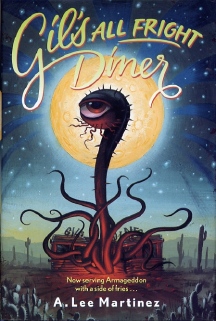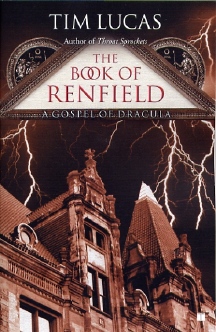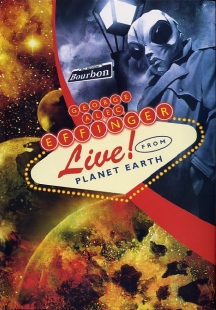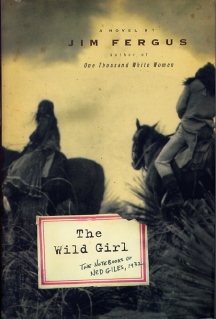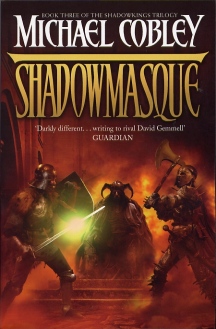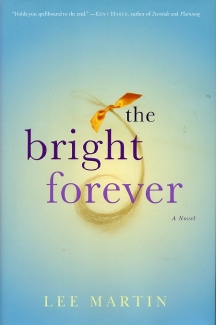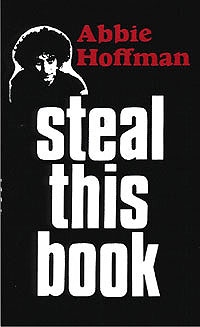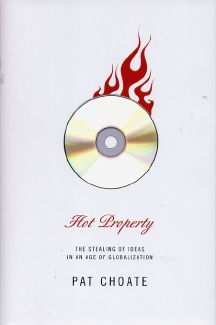|
|
|
This Just In...News from the Agony Column
|
05-06-05: A. Lee Martinez Opens 'Gil's All Fright Diner' |
|||
You
Want Fries With that Finger?
Duke and Earl stop at Gil's All Night Diner for a bite to eat. Simple enough, no? Well, turns out that Loretta, the large-ish owner has a bit of zombie problem that she'd like Duke and Earl to solve. Duke's a werewolf, Earl's a vampire, no problem right? Not so fast. Problem. One of those pesky apocalypses is just waiting to happen, as it happens. Presumably Duke & Earl will head it off at the pass, so that they may live to return in the first of many sequels. Martinez is clearly taking a page from Joe R. Lansdale's 'Drive In' books here. Monsters, gore, humor, Texas. How do you know the end of the world is approaching? Well, perhaps you know it's well on its way -- perhaps has already come to pass -- when Tor is publishing silly horror novels in hardcover. Now, I'm a fan of silly horror novels, but they have a sort of binary state. Either they work, and you buy them from page one to page x; or they don't and you read till about page twenty and then give up on the humorous horror genre for a while. Fortunately, it's pretty easy to pick up this novel and see for yourself which side of the switch it's on as far as youre concerned. Interesting here is that A. Lee Martinez gets a first horror novel in hardcover, while Joe R. Lansdale, who blurbs on the back cover, gets his latest 'Drive-in' novel published by the small press. I suspect that this means that horror is once again popular, and publishers will once again forget what happened last time they flooded the market. They brought about the end of the horror genre, for a while at least. The horror genre seems to need its own Duke and Earl to head off the coming catastrophe. You'll know the signs. The real question here is who, exactly gets to pronounce the horror genre as "dead". Now wait a moment -- it's already been pronounced as "dead". Does this mean the genre of zombies is a zombie genre? How can you kill whats already dead? Trust me, publishers will find a way. A note to readers, TAC will resume usual verbosity next week. And cover all those delectable choices in the rolling shelves. |
|
05-05-05: Tim Lucas 'The Book of Renfield' |
|||
Another
Cutting Edge
Sure, the horror genre had been circling the drain for a while in 1994. In fact, it was already looking up that damn drain. But when Dell dropped Abyss and replaced it with Cutting Edge, it seemed that there was one last glimmer of hope for the horror genre. Two great titles came out right off the bat. One was 'The Butcher Boy' by Patrick McCabe. McCabe went on to become an acclaimed literary author, bagging a Booker and Stoker nomination for 'The Butcher Boy'. The other was 'Throat Sprockets' by Tim Lucas. 'Throat Sprockets' was the kind of obsessive, weird novel that depresses you as much as it frightens you, the kind of novel that in depressing you so much manages to frighten you even more. Lucas, the editor of the acclaimed magazine Video Watchdog, seemed to be on the edge of great things. It was almost as if between Lucas and McCabe, the whole slide of horror was to be reversed. The smog would be blown out of Southern California; the strip malls would be overgrown with trees. Alas, it was not to be. The Cutting Edge had turned out to be the trailing edge, and I saw no more novels by the talented Tim Lucas. Until earlier this week. That's when I first saw 'The Book of Renfield: A Gospel of Dracula' (Touchstone / Simon And Schuster ; June 2, 2005 ; $14.00). Just in the midst of a remarkable new bloom of horror. Well, maybe its not that remarkable. Twelve years of Republican rule in the White House during the 1980's helped fertilize the first boom in horror, so we're now back in the equivalent of 1985, which puts Lucas on the actual cutting edge of a horror boom instead of the trailing edge. This is great news for readers, because it means that maybe, just maybe Lucas will get the follow-through he deserves before the publication of horror implodes under the weight of a million foil-covered gerund titles as they arrive on the grocery store racks. For Lucas, this novel offers the perfect platform to display his writing talents. I'll have to admit that as far as Dracula goes, I've never found any of the characters particularly compelling. Jonathan Harker is a wimp, Van Helsing is something of a pompous ass, and Dracula himself is sort of a cipher, and Lucy is well, loose. But Renfield. Fly, spider, rat-eating Renfield was always the one character in the novel that really appealed to me. 'The Book of Renfield' chronicles the life of the man who seemed to be mad, who indeed was an inmate of a nearby asylum, but who was not at all mad -- merely touched by the proximity of Dracula. Lucas offers a variety of sources for his Renfield novel -- private diaries, professional journals, and recordings from Seward's sessions with Renfield. And the novel does not end with Dracula -- it ends in another very present day tragedy / atrocity. Interestingly enough, Simon and Schuster have even followed the format of 'Throat Sprockets' with a nice, tight trade paperback format. New to the mix is the 'Reading Group Guide'. Frankly, I'm not sure how much I like this innovation. But then, I'm not sure about reading groups in general. To my mind, reading and group are mutually exclusive terms. And, I have to admit that a reading group guide at the end of a book is a sign that the book itself is far too well known for me to be reading. |
|
05-04-05: George Alec Effinger Live! From Planet Earth |
|||
Our
Favorite Writers Pick Their Favorite Stories
First and foremost among the selections is "The Aliens Who Knew, I Mean, Everything," a story so popular that it garners not only an introduction from Michael Bishop that itself is split into a before and after-word, but also an additional actually-after-the-story afterword by George Zebrowski. Bradley Denton selects and introduces a couple of stories, as does Barbara Hambly. Neil Gaiman selects 'Seven Nights in Slumberland' and recounts his first experience of Effinger's work in a Fafhrd and the Grey Mouser comic. For this reader, the standout collection here is the set of never-before-collected O. Niemand stories that Effinger wrote, mostly for Gardner Dozois, who provides the introduction to them. This is a set of eight stories that Effinger wrote under the pen name of "O. Niemand". Even I recall enough from my German language lessons to know that niemand is the German word for nobody. What Effinger did with these stories was to write recognizably in the style of other writers. Thus you get "Afternoon Under Glass" in the mode of Ernest Hemingway, "Put Your Hands Together", written in the style of Flannery O'Connor, "The Day the Invaders Came", channeling James Thurber, "The Man Outside", in the style of John Steinbeck -- well, you get the idea. So the reader can journey down memory lane with Effinger, recalling your own encounters with Thurber or O'Connor. I have to admit that seeing Thurber's name there really shocked me, and brought back a deluge of memories from my pre-teen years when I collected everything Thurber wrote in a series of trade paperbacks. Damn, where did those go? Where did the time go? In the interim, readers can enjoy the as-ever gorgeous packaging from Golden Gryphon. The cover image is by the soon-to-be-ubiquitous John Picacio, and it's nice enough to warrant one of my pop-up pages. Picacio manages to capture the manic variety that Effinger brings to the party, the otherworldly wit and the wild colors. All black and white, in color. |
|
05-02-05: Lee Martin Plunges Into 'The Bright Forever'; 'Hot Property: Stealing Ideas in an Age' of Globalization by Pat Choate |
||||||
Form Follows Content
Yes, I'm sure that, given the cover image, you can see where I'm headed. 'The Bright Forever', both design-wise and subject-wise bears more than a little resemblance to the mind-bogglingly huge best-seller by Alice Sebold 'The Lovely Bones'. Any reader who really enjoyed 'The Lovely Bones' will either A) Pick up the 'The Bright Forever', read the dust jacket and hopefully the first few pages, then buy the book, or B) Glance at it just long enough for the similarity to reveal itself to their no-doubt cluttered memories, then pass it by because 'The Lovely Bones' is of course the only novel titled 'The Lovely Bones' that in fact is 'The Lovely Bones'. And that would be a shame. Because, taken on its own terms, 'The Bright Forever' seems like a pretty damn compelling novel. Forget the coincidence of subject. It's just that; coincidence. You have an attention grabbing first chapter that I can reproduce here: Raymond R. I'm not saying I didn't do it. I dont know. Well, you've got me turning the page. What unfolds involves a nine-year old girl who goes to the library one summer evening in the small Indiana town where she lives. The novel is told from the point of view of a number of the town's residents. It's a real smorgasbord of writing styles. You get first person -- and not just from Raymond R. You'll get tight third-person narratives, and the prose camera even pulls back for some more omniscient observations. The prose is utterly transparent, but this type of structure is a way for a writer to create almost unbearable tension. It's my guess that many copies of this novel will be read while readers are riveted to a chair in their gardens this spring and summer. 'The Bright Forever' is not 'The Lovely Bones'. It is a novel with a gorgeous blue cover and a literary heritage. Dont worry about form, function, precursors or antecedents. My guess is that those who open the novel to the first page will quickly forget about the cover of this book or any other. |
||||||
StealTh is Book
It's a different age now, and stealing a book is amazingly still pretty hard. On the other hand, it's a breeze to steal music or software or even movies -- though I must admit I've figured out how to rip a DVD. And as far as music goes, well, about the time it got easy to steal I developed a distinct disinterest in anything I didn't already have. I guess I might as well post my birthday as make such a statement, but there it is. Still, here I am giving all my valuable labor -- and a few books to alert readers -- away for nothing, zero, nada zilch. In fact, I'm paying for the privilege of giving away my work. So perhaps it would behoove me to sink my teeth -- yes, theyre still mine -- into Pat Choate's 'Hot Property: The Stealing of Ideas in An Age of Globalization'. (Alfred A. Knopf ; May, 2005 ; $26.95) Choate's book looks into what he calls intellectual property theft. But not everybody feels the same way about it. This is a very interesting area of concern. Once upon a time, the copyright laws made sense, but theyre clearly not cutting the mustard in the twenty first century. Choate's book takes us back to the basics, and gives us the background on how the establishment of patent and copyright protections helped propel a young American economy. But he doesn't stop there.
To be fair, Choate does give part of a page or so to Creative Commons, the organization that's working to change copyright as we know it. And his detailed history of the wars and legislative jockeying that's gone into creating the spaghetti-code laws that hamper and hinder more than the help is must-reading for those who hope to write new laws. "What is missing is the will of U. S. political leaders to confront those who are stealing U.S.-owned intellectual properties and with them the future of the American people." I'm not sure that this is in fact the case. Our leaders are perfectly happy to confront those who are stealing intellectual property, so long as they get their cut. They confront them and go on their merry way. What is really needed is not a new enforcement of copyright law. What's needed is an invention for the twenty-first century that is as innovative as copyright law was when it first appeared, in larval form, many hundreds of years ago. That solution will involve not just enforcement but a whole new vision of what it is to create and own ideas. And it may not be a solution that will send stocks soaring. This article © Rick Kleffel, 2005. All rights reserved. |
